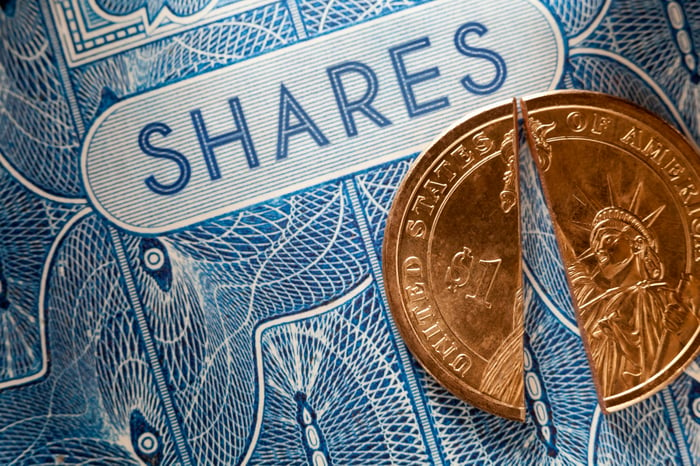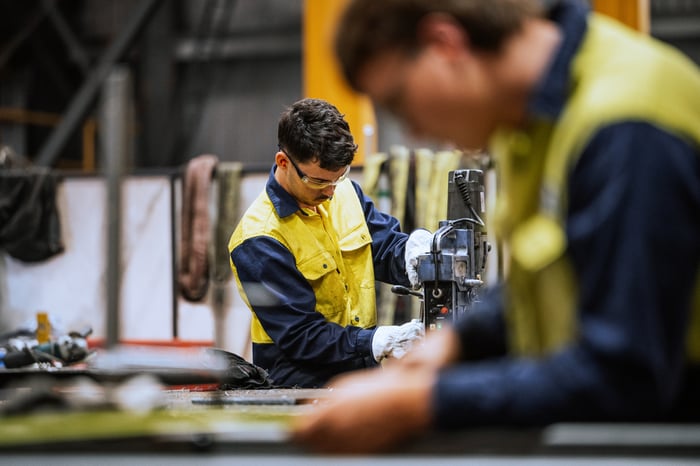For more than two years, artificial intelligence (AI) is the trend that's captivated the attention of Wall Street and everyday investors. The potential for AI to add $15.7 trillion to the global economy by 2030, based on estimates from PwC, has been too tempting for investors to ignore.
But artificial intelligence isn't the only trend responsible for pushing the Dow Jones Industrial Average, S&P 500, and Nasdaq Composite to numerous record-closing highs. Excitement surrounding stock splits has also played an essential role in lifting the tide on Wall Street.

Image source: Getty Images.
Stock splits are piquing investors' interest
A stock split is a tool publicly traded companies can lean on to superficially alter their share price and outstanding share count by the same magnitude. The "superficial" aspect of stock splits pertains to them not having any impact on a company's market cap or its operating performance.
Splits come in two varieties -- forward and reverse -- with the former overwhelmingly favored to the latter. Reverse splits, which are designed to increase a company's share price while simultaneously lowering its share count, are typically undertaken by struggling companies attempting to stave off delisting from a major stock exchange.
In comparison, forward stock splits are almost always completed by businesses that are out-innovating and out-executing their competition. If a company has to reduce its share price to make it more nominally affordable for investors who lack access to fractional-share purchases through their broker, it must be doing something right.
Forward splits are especially popular given the historic outperformance of the companies enacting them. Based on data from Bank of America Global Research, companies have averaged a 25.4% return in the 12 months following their forward split announcement since 1980. This more than doubles up the average return of the S&P 500 over the same 12-month timelines.
In 2024, more than a dozen prominent businesses completed stock splits, only one of which was of the reverse variety. This includes AI juggernauts Nvidia and Broadcom, retail giant Walmart, and restaurant chain Chipotle Mexican Grill.
Today, May 22, Wall Street's newest stock-split stock will take its place among the ranks.
Prominent stocks outside the tech sector have been announcing historic splits in 2025
Admittedly, stock-split euphoria has gotten off to a bit of a slow start in 2025 when compared to last year. But whereas 2024 prominently featured tech stocks taking the plunge, this year has featured non-tech highfliers announcing or completing forward splits.
The first brand-name business to announce a historic split in 2025 -- albeit not the company that's entering the stock-split ranks today -- is auto parts supplier O'Reilly Automotive (ORLY -0.23%). In mid-March, O'Reilly's board announced plans to conduct a 15-for-1 forward split, which is its largest ever, after the close of trading on June 9. This split will help lower O'Reilly's share price from almost $1,382 to close to $92 per share.
O'Reilly Automotive is a company that's directly benefiting from the aging of vehicles on American roadways. A May 2024 report from S&P Global Mobility found the average age of cars and light trucks in the U.S. hit an all-time high of 12.6 years, which is up from 11.1 years in 2012. The longer drivers hold onto their vehicles, the more likely it is that O'Reilly will benefit from parts and accessory sales to mechanics and consumers.
O'Reilly Automotive also has one of the most impressive share-repurchase programs on Wall Street. Since introducing its buyback program in 2011, almost $26 billion has been spent to repurchase more than 59% of the company's outstanding shares. Buyback programs of this scale can have a notably positive impact on earnings per share.
The next prominent stock that made history by announcing a forward split is automated electronic brokerage firm Interactive Brokers Group (IBKR 0.39%). The 4-for-1 split announced on April 15, which will go into effect after trading wraps up on June 17, is the first forward split in the company's history.
Interactive Brokers has thrived for years thanks to optimistic investor sentiment and lengthy bull markets. When Wall Street's major stock indexes are moving higher, it's normal for investors to put more money to work and to trade more often.
Additionally, Interactive Brokers has enjoyed growth in virtually all of its key performance metrics over the last two years. Since emerging from the 2022 bear market, the number of accounts on Interactive Brokers, customer equity on the platform, margin loans outstanding, and daily average revenue trades -- total customer orders divided by the number of trading days in a period -- have all moved higher.

Image source: Getty Images.
This stock-split stock is completing its ninth split in 37 years
But interestingly enough, the most recent brand-name company to announce its intent to split is the first to actually make it happen.
For the ninth time in the last 37 years, wholesale industrial and construction supplies distributor Fastenal (FAST -0.15%) is completing a split. The company's 2-for-1 split, which was announced on April 23, became official after the close of trading on May 21, with shares opening at their split-adjusted price today, May 22.
Since Fastenal's initial public offering (IPO) in August 1987, its stock has risen by 130,700% without dividend payments and 214,200% including dividends. Splitting its stock every few years has become part of the corporate culture and is indicative of a company that's firing on all cylinders.
One of the key catalysts behind Fastenal's outperformance is its inextricable ties to the health of the U.S. and global economy. Even though recessions are an inevitable part of the economic cycle, the average U.S. downturn since the end of World War II has lasted only 10 months. In comparison, the typical economic expansion has endured for about five years over the last eight decades. Demand for Fastenal's products should grow in lockstep with the U.S. and global economy.
Furthermore, about 73% of Fastenal's first-quarter sales came from its contract segment. "Contracts," per the company, include "national multi-site, local and regional, and government customers with significant revenue potential." In simpler terms, Fastenal's contract sales are tied to customers it has long-standing relationships with. These close-knit ties have helped push sales higher even amid plenty of macroeconomic uncertainty.
Fastenal's jaw-dropping 214,200% total return since its IPO is also a reflection of the company becoming more integrated in its customers supply chains. Fastenal's managed-inventory solutions, which include internet-connected vending devices (FASTVend) and bin stock-location monitoring (FASTBin), are used to learn about clients' purchasing habits and replenishing needs. Fastenal can help improve cost efficiencies for its customers while making itself irreplaceable to cyclically driven industrial companies.
At nearly 35 times forward-year earnings, Fastenal is certainly priced as a company that'll continue to outpace its peers in the growth column. While it wouldn't be a surprise to see its stock take a breather after effectively doubling since October 2022, I wouldn't bet against future gains three or more years down the line.





